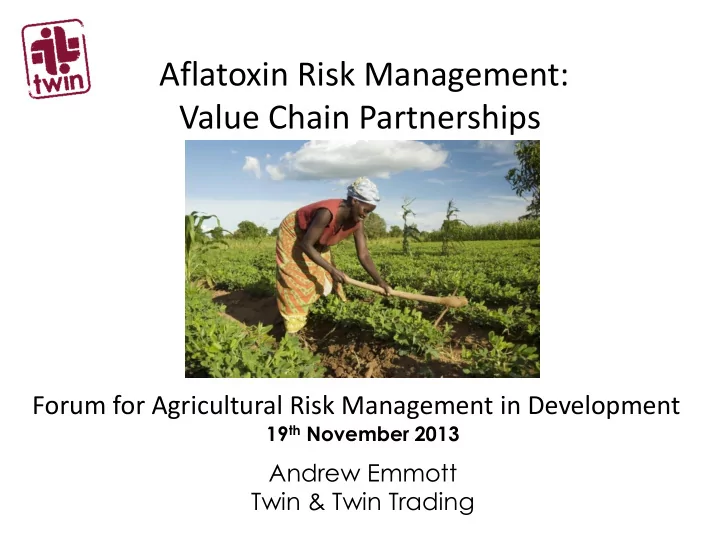

Aflatoxin Risk Management: Value Chain Partnerships Forum for Agricultural Risk Management in Development 19 th November 2013 Andrew Emmott Twin & Twin Trading
Twin & Twin Trading: Value Chain Partnerships Introduction: • Twin & Twin Trading established in 1985; – Twin (Charity); – Twin Trading (for profit); • Development through trade; – Built on trust & mutuality; – Smallholder value chains; • Smallholder producer-owned businesses; – Cafe Direct, Divine, Liberation, Afri-Nut; • Working through partnerships & networks; – Involved at start of PACA; – Supportive of MAPAC.
Twin’s groundn ut experience: Value chain partnerships • 1990’s – First experience of aflatoxin; – Projects in Eritrea & Gambia; • 2000 – 2003 – Consultation on whether or not to trade nuts; – Developed Fairtrade groundnut proposition; • 2004 – 2006 – First Fairtrade groundnut producers certified & started trading groundnuts; – Developed new supply chains in the EU; • 2007 – 2013 – Established Liberation Foods CIC ; – Facilitated Afri-Nut formation.
Aflatoxin and trade: Aflatoxin and groundnuts • Affects 25% of the world’s crops, (FAO) including groundnuts; • Has many entry points pre & post harvest eg: hand shelling groundnuts: – 4 billion hours pa spent hand shelling; – Shells soaked to ease hand shelling creates ideal conditions for Aspergillus sp.infection; – Poor drying & storage compounds the problem – Fungal growth stops at 7% m.c.; • Informal traders don’t check for aflatoxin & compete with the formal trade.
African groundnut exports • African market share ($220m pa) of exports collapsed; 90% in the 1960’s – Macro economics; and, – Aflatoxin regulations tightening. • China, Argentina & USA are the largest exporters (now $1.2b pa) ; 40 % in the 1970’s – Value chain investments; • African production declined but still <5% by 2005 2 nd largest producer @25%; – A women’s crop – food security; – Mainly in domestic & regional markets; – Consumers are largely unaware of the dangers of aflatoxin.
Malawi groundnut production & trade Malawi groundnut production & export 250000 • Exported > 40k mt pa to EU; 200000 – 1990’s exports & production 150000 Export collapsed; (tonnes) 100000 • Rebuilding exports supported Production 50000 (tonnes) by National Export Strategy; 0 1961 1966 1971 1976 1981 1986 1991 1996 2001 2006 2011 – Exports still <15% of production & limited exports to EU; Malawi groundnut export & waste • 60% consumed through (% of total production) 15.0 informal value chains; 10.0 – Very little is wasted. % Export (%) 5.0 Waste (%) 0.0 2000 2001 2002 2003 2004 2005 2006 2007 2008 2009 2010 2011
Formal vs informal value chains Controls in formal value chains: • Protect consumers in export, local retail & other markets; – Eg: Locally produced safe RUTFs for severely malnourished children; Informal value chains: • Improving quality will impact all consumers; – But there is little awareness or food safety & control of aflatoxin; • Few incentives to reduce aflatoxin levels; – Crushing contaminated crop for oil & meal relevant to formal & informal chains.
On farm sorting: Not enough poor crop discarded! <2% Tests on 260mt 60% used in food or feed of groundnuts sorted out Groundnut flour had most contaminated samples; – 73% > EU 4ppb level. – 25% above 100ppb & – highest = 3871 ppb • 70% of families add groundnut flour to Sources: meals ca. twice/ week ICRISAT (2011) & Twin GPAF (2013)
Improve food safety in all value chains Food security : when all people at all times have access to Introduce interventions at critical control points to increase the sufficient, SAFE , nutritious food to maintain a healthy & active life quantity of safe groundnuts for all consumers. Include food safety in sustainable development goals – with a Paradigm shift targeted at food loss to pull unsafe groundnuts (& similar approach to the provision of clean water and sanitation. other grains) out of human food chains and develop profitable alternatives eg: oil & meal.
Improve infrastructure, awareness & standards Storage Shelling Sorting
Recommendations Agricultural, health, nutrition, & value chain experts need to work together to: • Establish MAPAC coordination unit; • Support the accreditation of national mycotoxin laboratory; • Raise awareness of the public health impacts ; • Improve drying, shelling, sorting, & storage in all value chains; • Provide appropriate training & equipment; • Deliberately pull aflatoxin out of human food chains.
Thank you
Recommend
More recommend